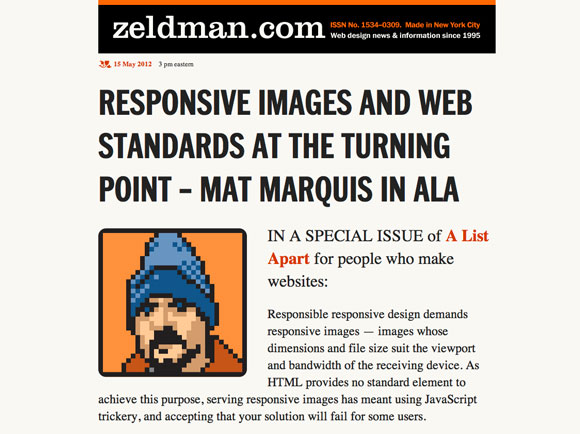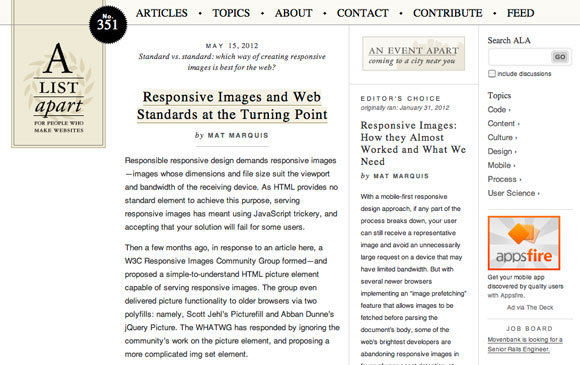10 QUESTIONS: Jeffrey Zeldman on the point of having web standards
Legendary web designer, and godfather of web standards, Jeffrey Zeldman answers YOUR questions.

Jeffrey Zeldman is among the best known web designers in the world. He is publisher and creative director of online magazine A List Apart and founder of design agency and consultancy Happy Cog, clients of which include Warner Bros. Pictures, Fox Searchlight Pictures and The New York Public Library.
Zeldman is widely considered a guiding force behind the web standards movement and independent web publishing. Here, he answers YOUR questions....
QUESTION: Salomon Dayan asked (via Twitter): "How can we accelerate the usage of web standards like HTML5?"
"Actually, HTML5 is chugging along quite nicely -- in 15 years advocating the stuff, I've never seen a web standard get accepted, adored, and deployed so fast. In part, this is because browser makers are driving the technology -- and, after all, they are the ones who will have to support it. Then there's the fact that HTML5 is designed for a web of applications, not just of documents. And that it includes important real-world publishing semantics like ARTICLE and SECTION that are designed for the demands of modern publishing and content management systems.
"Then too, HTML5 is backward compatible by design, meaning you can take advantage of its new features without worrying about catastrophic failure in old browsers and devices. Unlike XHTML, which was created for largely theoretical benefits, HTML5 was designed to solve real problems, be simple to understand and implement, and solve the end-user above all others.
"There are other reasons for HTML5's success, not all of them inspiring. (Some business leaders have embraced HTML5 in the mistaken belief that it is the new Flash, or out of insufficiently reflective Google or Apple fandom, and so on.) But regardless of *why* it is being adopted, there's no question that HTML5 is a hit.
On that level, then, the answer to your question is, you don't need to do a thing.
"You can, however, join the WHAT WG or the W3C to ensure that your voice as a designer/developer is heard as the standard evolves. It's one thing for the editor of HTML5 to declare that the spec is designed to be practical and solve real problems. It's another thing entirely for him to be held to that promise because designers or developers like you hold him to it by participating in the discussion around HTML and its features. I strongly encourage you to do that.
"I also encourage you to use HTML5. On the web, the technology that gets used the most is the technology that wins -- from HTML and (in the old days) Flash to Typekit and Twitter. The more you do with HTML5, the more your work will help sell it to other developers, clients, and site owners."
QUESTION: Simon Fisher asked (via email): "Where do you find inspiration?"
"I take inspiration from the designers and developers around me -- from the few who literally share my work space, to the many who share their work and their lives online. I take inspiration from walking and admiring New York City, my adopted home of 20-plus years.
"From art and music (lots of music), film and fiction. Regular weight and cross training inspires me by turning off my work-brain for sixty minutes at a stretch, forcing me to focus on the mind-body connection. When I plunge back into my work life (after a shower, hopefully), my unconscious has solved some creative problems and I've let go of some of the daily business and life anxieties that can get in your way as a creative person (it's hard to create a masterpiece when you're sweating the rent bill).
"Last but hardly least, I take inspiration from interacting with my daughter. Children are magical beings, loving, creative, and idealistic. It's impossible to stay dull after spending time with such bountiful sources of light, energy, hilarity, and sorrow.

QUESTION: Kevin Rain asked (via Facebook): "What's the point in having web standards when the same code looks different across different browsers?"
"With CSS, HTML, JavaScript, and web fonts, it is possible to create websites that look and behave virtually identically in modern browsers and operating systems. If you design using progressive enhancement, visual and behavioral differences in older browsers will be consciously designed; the user won't know the difference and won't care.
"But while modern browsers and web standards give us the tools to ensure consistent experience across desktop browsers, it is important to recognize that desktop browsers are only one context in which our sites and applications must work -- and no longer the preeminent context.
"Indeed, there is now no single preeminent context for our work. Our sites must perform on great platforms like iPhone, iPad, and Android; on half-baked platforms and crummy phones; on TVs with good browsers but bad UI; in short, everywhere. Worrying about maintaining pixel-perfect look and feel across all these platforms and devices is missing the point; designing with ideas like progressive enhancement, adaptive design, and responsive design is what we should be doing, and all these ideas come out of the web standards movement.
"Far from being obsolete, web standards prove their worth the more devices, browsers, and platforms come online. If you want pixel-perfection, design for iPad only ... and abandon hundreds of millions of potential users. Or design with standards, and serve everyone. Easy choice."
QUESTION: Bram Vanroy asked (via Facebook): "What will come after HTML5 and what are future improvements that are necessary to create a faster, more user-friendly and safer cross-browser experience?"
"According to WHAT WG, the original framers of HTML5, there is no HTML5 now. There is only HTML. It is a language that will continue to evolve forever. According to the W3C, after HTML 5 will come HTML 6 (or perhaps HTML 5.1).
"The W3C makes itself responsible for collating changes to the evolving specification and freezing them in amber at various key moments, so that a series of permanent, stable standards emerges -- standards that browser makers can build against and developers can write to, because they are known and permanent.
"What I write in HTML5 should continue to work indefinitely, just as what I wrote in HTML 4.01 or XHTML 1.0 will always work.
That's why there's no need for us to worry that markup we write against today's HTML will stop working when HTML evolves. Strange as it may seem, this division of labor between the W3C and the WHAT WG makes sense, as it ensures stability (via the W3C) while encouraging experimentation, innovation, and progress (via the WHAT WG)."
And on future improvements...
"We need a standard for responsive images. For now we can get by with JQuery, but even that isn't foolproof. There should be standard semantic markup that serves viewport-and-bandwidth-appropriate images.
"This should be part of modern HTML, the same as VIDEO is part of HTML today, and, per the design principles of HTML5, it should be simple to implement and understand ("avoid needless complexity"). The proposed PICTURE element proposed by the W3C Responsive Images Group, while perhaps not perfect, is easy to understand and implement, and there are even brilliant polyfills that enable it to work today. To participate in this activity, or get up to speed on what has been done, join or visit the W3C Responsive Images Group.

QUESTION: Richard Webster asked (via email): What is your proudest achievement to date, and why?
"My daughter's smile -- followed by the adoption of web standards worldwide by browser makers and many designers and developers."
QUESTION: Axel Vankrunkelsven asked (via Facebook): "Why is internet explorer still legal to use? Shouldn't it be banned?"
"We need to find something new to complain about. IE9 and IE10 are quite good. Microsoft has been auto-updating nearly all its users to at least IE8. Use of IE6 is well below 1% in the US. If you put the user first and design with progressive enhancement, there is no reason to worry or complain about IE.
"Of course, if your boss insists that you create layouts that are pixel-for-pixel identical in all browsers, and half your users are on IE6, then my heart goes out to you and you do have a legitimate reason to complain about IE -- at least, about the version you're stuck with.
"But more importantly, you have a reason to complain about your job. Try to educate your boss about progressive enhancement, accessibility, and the importance of creating great *experiences* for all (rather than pixel-for-pixel visual experiences that take forever to load because they require so much code and so many workarounds).
"If you can't change the culture at your place of work, quit and find a new job. People like us, who know what we are doing, are in high demand. The internet is incredibly robust economically. There's no reason any of us needs to settle for a stupid, dead-end, go-nowhere job. In short, if you're complaining about IE in 2012, the problem isn't Internet Explorer ... it's your job. But you can fix that."
QUESTION: Bob Maine asked (via email): "What advice would you give to someone starting out in web design?"
"Read .net magazine, A List Apart, and Smashing Magazine."
QUESTION: Ruth Hamilton asked (via email): "What are you currently working on?"
"At Happy Cog, we are beginning to wrap a two-year engagement on the US Holocaust Memorial Museum. At A Book Apart, we've just published Mike Monteiro's Design Is A Job, and Jason Santa Maria's On Web Typography is coming soon.
"A List Apart and An Event Apart's websites are both being redesigned, with some surprising new features in store for ALA. I'm redesigning my personal site (zeldman.com) in public, experimenting with big type and a "fixed width responsive design," where type size depends on the approximate width of the viewing device, but the rest of the layout -- including width -- doesn't change. One Layout To Rule Them All!"
QUESTION: Paul Annett asked (via Twitter): "What's your favourite colour?"
"Unicorn."
Thanks Jeffrey! And thank you to everyone who sent in questions. Make sure you stay tuned to see who we'll be interviewing next week.
Which other designers do you have burning questions for? Let us know in the comments box below...

Thank you for reading 5 articles this month* Join now for unlimited access
Enjoy your first month for just £1 / $1 / €1
*Read 5 free articles per month without a subscription

Join now for unlimited access
Try first month for just £1 / $1 / €1
Get the Creative Bloq Newsletter
Daily design news, reviews, how-tos and more, as picked by the editors.

The Creative Bloq team is made up of a group of design fans, and has changed and evolved since Creative Bloq began back in 2012. The current website team consists of eight full-time members of staff: Editor Georgia Coggan, Deputy Editor Rosie Hilder, Ecommerce Editor Beren Neale, Senior News Editor Daniel Piper, Editor, Digital Art and 3D Ian Dean, Tech Reviews Editor Erlingur Einarsson, Ecommerce Writer Beth Nicholls and Staff Writer Natalie Fear, as well as a roster of freelancers from around the world. The ImagineFX magazine team also pitch in, ensuring that content from leading digital art publication ImagineFX is represented on Creative Bloq.
